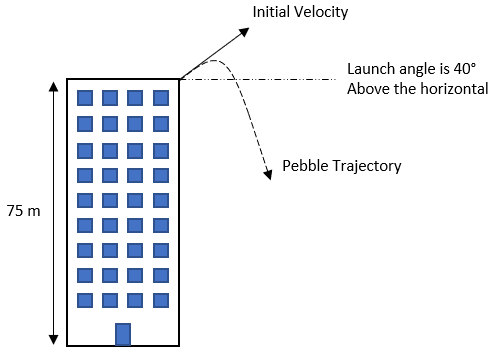Pebble Off a Building
Consider a pebble is thrown off the roof of a 75 m tall building at 40° above the horizontal. If the initial velocity is 10 m/s, what horizontal distance from the origin will the pebble land on the ground? Ignore friction.

Expand Hint
First, calculate the x and y components of the initial velocity:
$$$v_x=v_0cos(\theta)$$$
$$$v_y=v_0sin(\theta)$$$
where
$$v_0$$
is initial velocity, and
$$\theta$$
is the launch angle above the horizontal in degrees.
Hint 2
Calculate the time it takes the pebble to reach its maximum height:
$$$v=at+v_0$$$
where
$$v$$
is the final velocity,
$$a$$
is acceleration due to gravity,
$$t$$
is time, and
$$v_0$$
is initial velocity.
First, calculate the x and y components of the initial velocity:
$$$v_x=v_0cos(\theta)=(10m/s)cos(40^{\circ})=(10m/s)(0.766)=7.66\:m/s$$$
$$$v_y=v_0sin(\theta)=(10m/s)sin(40^{\circ})=(10m/s)(0.643)=6.43\:m/s$$$
where
$$v_0$$
is initial velocity, and
$$\theta$$
is the launch angle above the horizontal in degrees. Next, let’s analyze the pebble’s vertical motion (which involves using
$$v_y$$
as the initial velocity). To calculate the time it takes the pebble to reach its maximum height:
$$$v=at+v_0$$$
where
$$v$$
is the final velocity,
$$a$$
is acceleration due to gravity,
$$t$$
is time, and
$$v_0$$
is initial velocity.
$$$0m/s=(-9.8m/s^2)t+6.43m/s$$$
$$$t_{up}=\frac{-6.43m/s}{-9.8m/s^2}=0.66\:sec$$$
To calculate the pebble’s max height from being initially thrown:
$$$y=\frac{1}{2}at^2+v_0t+y_0$$$
where
$$a$$
is the acceleration due to gravity,
$$t$$
is the time,
$$v_0$$
is the initial velocity, and
$$y_0$$
is the initial starting height. Thus,
$$$y=\frac{1}{2}(-9.8m/s^2)(0.66s)^2+(6.43m/s)(0.66s)+75m$$$
$$$y=(-4.9m/s^2)(0.44s^2)+4.22m+75m$$$
$$$y=-2.16m+4.22m+75m=77\:m$$$
Next, we can reuse the same equation to determine the time it takes the pebble to free fall from maximum height. Since the object is free falling from rest (
$$v_0=0$$
&
$$y_0=0$$
):
$$$y=\frac{1}{2}at^2\to 77m=\frac{1}{2}(9.8m/s^2)t^2$$$
$$$t^2=\frac{(77m)(2)}{9.8m/s^2}=\frac{154}{9.8}s^2=15.7s^2$$$
$$$t_{down}=\sqrt{15.7s^2}=3.96\:sec$$$
Therefore, the total time the pebble is in the air:
$$$t_{total}=t_{up}+t_{down}=0.66s+3.96s=4.62\:sec$$$
Looking at motion in the horizontal direction, we can finally solve for the total distance traveled in the x direction:
$$$x=v_xt=(7.66m/s)(4.62s)\approx 35\:m $$$
35 m
Time Analysis
See how quickly you looked at the hint, solution, and answer. This is important for making sure you will finish the FE Exam in time.- Hint: Not clicked
- Solution: Not clicked
- Answer: Not clicked
Similar Problems from FE Sub Section: Constant Acceleration, Projectile Motion
Similar Problems from FE Section: Particle Kinematics
018. A Pebble on a Mountain
030. Newton's 2nd Law
037. Motorcycle's Velocity
088. Constant Acceleration
122. Roller Coasters
158. A Train's Velocity
165. Velocity Plots
313. Projectile Motion
316. Jet Ski
321. Traveling Train
322. Aircraft Carrier
394. Acceleration
412. Hill Bomb
444. Electron Motion
487. G-Force
488. Block Speed
515. Initial Velocity
556. Golf Angle
635. Downhill Skiing
637. Motor Boat
658. Hockey Puck